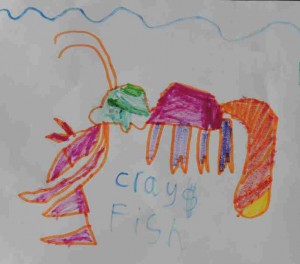Save Our Freshwater Crayfish
The only crayfish native to the British Isles is the endangered European Freshwater Crayfish Austropotamobius pallipes and it’s in big trouble.
Also known as the White-clawed Crayfish, it inhabits rivers, streams, canals and lakes. There used to be loads in the River Kennet near where Henry and Catherine live.
Their ideal habitats are water bodies with a moderate freshwater flow and lots of other invertebrates like mayfly and molluscs. They use tree roots and rocks in the banks for shelter. The babies use vegetation such as watercress and grass matting growing out of the bank for shelter while adults hide among underwater rocks and submerged logs.
Olive-brown in colour, with pale-coloured undersides to the claws, the native freshwater crayfish only grows to around 12cm long.
Once it was widely distributed throughout Britain, but its range has rapidly shrunk and it is currently restricted to central and northern England and Wales. One of the major reasons for the decline is the introduction of an invasive species the North American Signal Crayfish (Pacifastacus leniusculus).
The Signal Crayfish is larger than our native species and outcompetes it for the same food sources – it’s also a cannibal and will eat the smaller native crayfish species and even its own babies. This invading bully also competes with native fish for food and is a predator on all life stages of small aquatic animals. The Signal Crayfish damages river systems by making burrows in the banks (interconnecting burrows of up to 2 metres deep) leaving them prone to collapse. This presents a hazard to human health and safety by weakening walkways and of the river side and impacts on the flood defence of the affected areas – in effect it wreaks havoc and destroys freshwater ecosystems.
The Signal Crayfish is also a carrier of the ‘crayfish plague’ – a disease caused by a specialised parasite that only infects the crayfish species. Signal crayfish, unless otherwise stressed, do not succumb to crayfish plague; however, white-clawed crayfish populations have been devastated by the disease. The native British species is also more sensitive to pollutants and insecticides which run off into waterways.
The underside of the Signal Crayfish is red in colour; adult males longer and wider than females. Males are up to 30cm in length, females up to 15cm; much larger individuals have been recorded.
Remember the native white-clawed crayfish is an endangered species so please try not to disturb this species.


